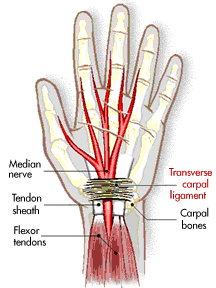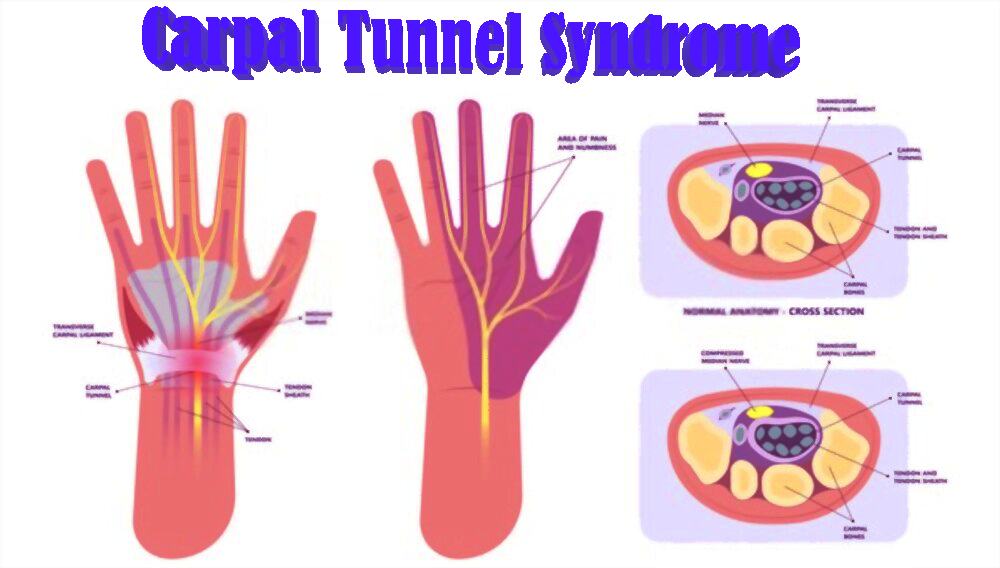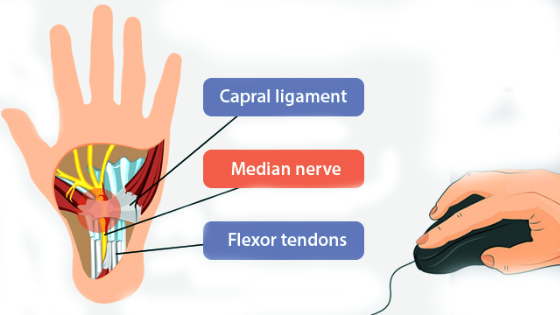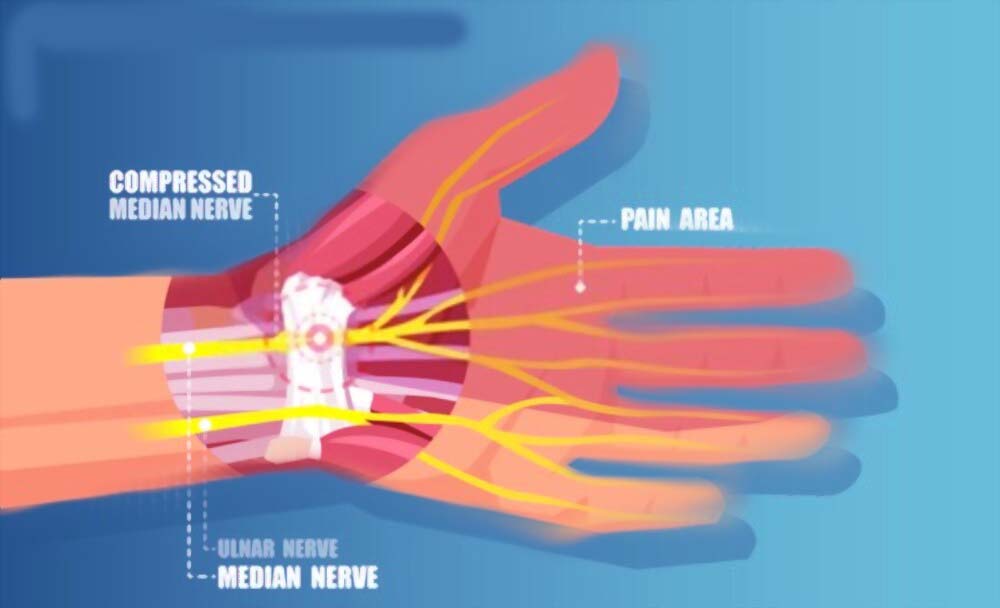
| Carpal Tunnel Syndrome is the fastest growing occupational illness in the United States, affecting over 250,000 workers. Anyone who performs repetitive tasks with their hands, such as typing, working on an assembly line or playing the guitar, is at risk. Learn what you can do to prevent or treat this debilitating hand disorder before it causes permanent damage. The median nerve can become compressed as it passes through the carpal tunnel, causing pain and numbness and impairing movement of the hand and fingers. |
Data processors, secretaries, cashiers, assembly-line workers, meat packers, writers and musicians often get the same workplace injury. What is their common risk factor? All have jobs that require them to use their hands in repetitive movements over and over again. The result is a debilitating hand disorder called carpal tunnel syndrome (CTS) which, according to the Bureau of Labor Statistics, is the fastest growing occupational illness. The American Society of Plastic and Reconstructive Surgeons estimates CTS claims over 250,000 victims a year—two-thirds of which are women. The high prevalence among women is due to the types of jobs they hold, and some experts believe the swelling caused by their monthly cycle or by pregnancy can raise their risk as well. But this condition is often preventable if you know how to position your hands properly during repetitive tasks (especially those involving pinching or gripping with the wrist flexed) and how to recognize and treat early signs of trouble.
How Does Carpal Tunnel Syndrome Occur?

The carpal tunnel is a narrow passageway of bone and ligament in your wrist. The median nerve, which controls sensation in the fingers and movement in some of the muscles in the hand, passes through this tunnel along with some of the finger tendons. Repeated hand or wrist movement can put stress on the tendons, causing them to swell and press on the median nerve. Such pressure causes pain and numbness, and it impairs movement in the hand and fingers. Also, keep in mind that CTS often accompanies other diseases or events. For example, some pregnant women find that their tendency to retain water and gain weight leads to CTS (symptoms usually disappear after childbirth). In addition, some disorders, such as diabetes and rheumatoid arthritis, can leave a person prone to CTS.
What Are the Signs of CTS
In early or mild cases of CTS, the following symptoms may be intermittent, but they can become persistent if the condition is not treated.
• Decreased mobility of the fingers, hand, elbow or shoulder (or any combination of them)
• Decreased hand strength
• Dull aching discomfort or pain that occurs most commonly at night or in the early morning
• Severe pain that awakens you from sleep during the night
• Wrist pain that radiates to the forearm, shoulders, neck and chest
• Dry skin, swelling or color changes in the hand
• Weakness of the thumb
• Tingling in all but the little finger
• Numbness in the hand, resulting in weakness or clumsiness
CTS can be caused by anything that presses against the nerve, such as a cyst on the tendon or rheumatoid arthritis. Most often, however, CTS is caused by inflammation due to overuse of the tendons. Occupational health experts agree that to prevent serious repetitive motion injuries you should pay prompt attention to the first sparks of pain—ignoring symptoms for six months makes it likely that the numbness or spasms will become permanent. To keep this problem from arising in the first place, try the following preventive measures:
• Avoid doing repetitive hand motions with a bent wrist. Keep the wrist straight and relaxed when you write, type, draw, drive, use power tools, pliers, or scissors, play musical instruments, or do needlework.
• Take frequent breaks (five minutes each hour) from repetitive hand motions to: Stretch your fingers and thumb; Do wrist curls and circles; Change your grip.
• Avoid sleeping on your hands

Don’t ignore wrist pain. Stop the activity that triggered the problem and try some home treatments. If the symptoms decrease, resume the activity gradually, while making an effort to keep the wrist straight. If you cannot stop the activity, try to change the way you do it so that your wrist is not stressed. Try to alternate tasks so that you don’t spend more than one to two hours at a time doing one that involves your hands.
• Gently warm up your hands before starting work. Do some wrist circles and stretch your fingers and wrists (see Wrist Exercises). Repeat every hour.
• Use a wrist support pad with your computer keyboard to help maintain the straight alignment of your wrist (See Working Safely).
• Apply ice or a cold pack to the palm side of the wrist for five to ten minutes as needed.
• Use an over-the-counter anti-inflammatory pain reliever, such as aspirin or ibuprofen.
See your doctor if: the pain or numbness is severe and is not alleviated by rest and a normal dose of pain reliever; your hand grip becomes weak; minor symptoms do not improve after a month of home treatment; any numbness remains after one month of self-treatment (long-term numbness can lead to permanent loss of hand function).
There are a number of treatments your doctor may use to alleviate CTS. Using a wrist splint, which keeps the wrist straight or slightly extended (no more than 15 degrees), during the day and/or night may help. Try to combine a splint with a real effort to change the positioning of your hand during the activity that causes you pain so that the problem doesn’t recur once you no longer use the splint.

If a splint and anti-inflammatory medications, which reduce swelling around the nerve, don’t ease the condition, your doctor may recommend a steroid injection. This may be warranted if you continue to have considerable pain or persistent numbness. Such shots should be given by a rheumatologist, hand specialist or other physician who is experienced in the procedure.
If these treatments are ineffective, or if you develop weakness in your thumb at any time, you may need carpal tunnel release surgery to relieve pressure on the nerve. In this procedure, the surgeon (usually an orthopedic surgeon) cuts the carpal tunnel ligament, which covers the median nerve, to relieve the pressure on that nerve. This is usually a simple operation that can be done on an outpatient basis. Results from surgery are generally quite good if severe weakness has not developed.
Exercises to keep your wrists safe
The following exercises will help stretch and strengthen your wrists. Keeping your wrists strong and flexible, and alleviating strain on the carpal tunnel by stretching your wrists often during the day, can help prevent injury. These exercises should be done three to five times a week. (A sixteen ounce soft-drink bottle or can of food can be used instead of a dumbbell.) note: Do not do these exercises if you already have pain or numbness. They are meant as a preventive measure and may aggravate an existing problem.

1) Limbering up:
- • Massage the inside and outside of hand with thumb and fingers.
- • Grasp fingers and gently bend back wrist. Hold for five seconds.
- • Gently pull thumb down and back until you feel the stretch. Hold for five seconds.
- • Clench fist tightly, then release, fanning out fingers. Repeat five times.
2) Wrist Rotation:
Stand or sit with your elbows close to your waist, your forearms extended in front of you and parallel to the floor, and your palms facing down. Make fists with both hands and make circles with your fists in one direction. Do 10 repetitions, then reverse the direction. Next, open your hands, extend your fingers and repeat the entire sequence.

3) Wrist Curl:
Stand or sit with your elbows close to your waist, your forearms extended in front of you and parallel to the floor, and your palms facing down. Grasp a one-pound dumbbell in each hand and slowly bend your wrists down, holding for five seconds. Do 10 repetitions.

4) Sideways Wrist Bend:
Stand or sit with your elbows close to your waist, your forearms extended in front of you and parallel to the floor, and your palms facing down. Grasp a one-pound dumbbell in each hand. Keeping your forearms still, slowly bend your wrists from side to side, moving the weights toward, then away from one another in a windshield wiper-like motion. Do 10 repetitions.

5) Wrist Twist:
Stand or sit with your elbows close to your waist, your forearms extended in front of you and parallel to the floor, and your palms down. Grasp a one-pound dumbbell in each hand and slowly turn your wrists and forearms until your palms are facing up, then turn them down again. Do 10 repetitions.
Working Safely: Tips For The Office
The following tips can help you avoid CTS in the office:
• Make sure your computer is set up for the most comfortable work environment. Your computer screen should be about two feet away from you and just below your line of sight.
• Set up your keyboard so it is flat rather than slanted down. You can use a three-quarter inch support under the keyboard to accomplish this.
• Keep your wrists straight, your forearms parallel to the floor and your elbows bent at right angles while typing.
• Movable forearm rests that attach to the chair or a wrist rest to put in front of your keyboard can help keep your wrists straight and in place. However, you should never place your wrists on the pad while you work. Always let them hover about a half-inch above it.
• You know your chair is the perfect height if you can sit at your computer with your knees bent at right angles and your feet flat on the floor.
• Rest your wrists when you are not typing.
• Take frequent short breaks. Several brief respites do your wrists a lot more good than a single long one.
• Stretch your wrists before you start to work and during breaks, and strengthen your wrists with exercise.
• Exercise regularly. Overall body conditioning seems to help guard against repetitive motion injuries.
• If you type standing up, as do clerks at car-rental agencies, you are at special risk because counters are usually not high enough to allow for proper wrist position. You must be sure to do enough stretching and strengthening exercises to counteract this problem or ask your employer to adjust your work station.




